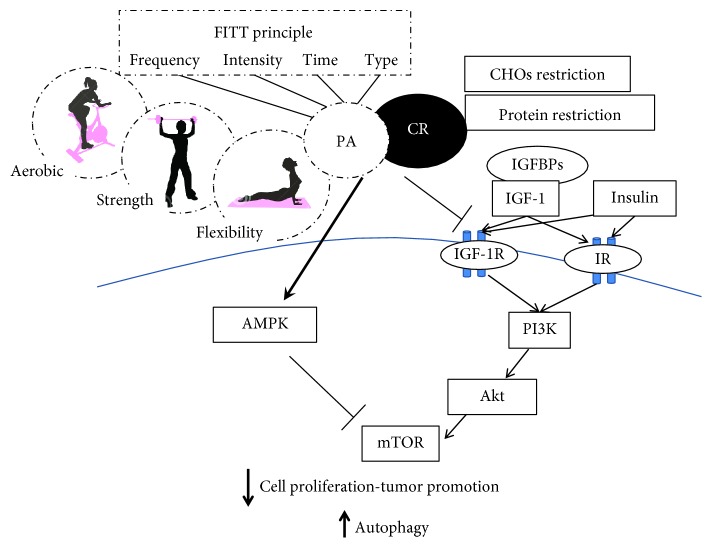Figure 1.
In this figure, we consider potential mechanisms regulated by physical activity and caloric restriction in inhibiting the mTOR pathway. Both refer to energy availability inhibiting carcinogenesis by suppressing the activation of the mTOR signaling network in this subtype of mammary carcinoma. The mTOR inhibition is mediated through the effects of vigorous PA or long-term exercise on systemic response such as concentrations of the circulating growth factors and hormones (i.e., IGF-1 and insulin) that regulate the mTOR network. The network is controlled through the PI3K/Akt signaling pathway, the glycaemia and glutamine levels, inducing apoptosis and reversing malignancy-associated metabolic programming. Moreover, the control of energy availability by both exercise and CR induces a mitohormetic response that accounts for a physiological cellular stress adaptation through AMPK activation inducing mTOR inhibition. In this context, exercise should be considered in terms of its four components: frequency, intensity, time, and type; however, dose-dependent effects of each component on cancer protection via mTOR inhibition have not yet been clarified. Most data indicate that vigorous PA, either long-term or in adulthood, may reduce a woman's risk of mammarian cancer, especially TNBC relapse. The inhibition of the mTOR complex and its cell growth-promoting functions leads to a reduction of cell proliferation, control of cancer progression, and consequent autophagy induction probably involved in tumorigenesis prevention. Thus, we hypothesized that the exercise-induced inhibition of the mTOR pathway may be useful in the control of cancer progression, including TNBC. PA: physical activity; CR: caloric restriction; CHOs: carbohydrates; mTOR: mammalian target of rapamycin; IGF-1: insulin-like growth factor 1; IGF-1R: insulin-like growth factor receptor 1; IR: insulin receptor; IGFBPs: insulin-like growth factor binding proteins; PI3K: phosphatidylinositol-3-kinase; AMPK: adenosine monophosphate-activated protein kinase; TNBC: triple-negative breast cancer. FITT-VP principle, which reflects the frequency (F), intensity (I), time (T), and type (T) of exercise, and its volume (V) and progression (P) over time, in an individualized exercise training program.

